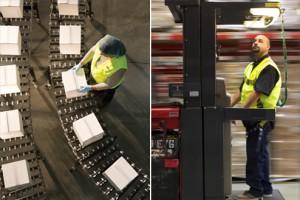 Logistics and materials handling can be viewed as getting products from point A to point B safely and on time. But what happens between those two points – even before products arrive at point A – can determine the success of the shipment. With the retail holiday season and its “fast in, fast out” timetables facing most shippers, it’s time to ensure the materials handling equipment (MHE) systems are in place, stocked up, and tuned up for peak efficiency for any warehouse or cross dock operation.
Logistics and materials handling can be viewed as getting products from point A to point B safely and on time. But what happens between those two points – even before products arrive at point A – can determine the success of the shipment. With the retail holiday season and its “fast in, fast out” timetables facing most shippers, it’s time to ensure the materials handling equipment (MHE) systems are in place, stocked up, and tuned up for peak efficiency for any warehouse or cross dock operation.
Whether getting product from one dock to the next in a cross dock setting, or from a dock to warehouse rack location, or even onto a truck to its final point of delivery; safe and efficient materials handling involves numerous variables. Shippers must determine the type and weight of the materials; the types of containers required, including boxes, bags, pallets, even garment-on-hanger; and any unique handling requirements, especially for food, liquid, or fragile materials. This all will impact the MHE selected for the job at hand.
Ready to prepare your MHE operation for the coming season – and beyond? These seven strategies can help:
- Be flexible, fluid, and fast. Throughput for the holidays can be high-velocity and time-sensitive. This is only exacerbated, in one example, in multi-client cross dock settings, where different customers have different material handling needs. From the use of conveyors, wheeled dollies, even forklifts, to cross docking systems – with customer products spec’d, measured, and weighed to ensure products can fit your MHE systems – research your client material requirements.
- Stock up to reduce downtime. Perform preventive maintenance during slow times to ensure uptime during peak periods. Have contact information handy for key repair providers. Next, because space often is at a premium, maintain adequate on-site stock of commonly used materials, stretch film, labels, banding materials, and the like, and have an inventory process in place to ensure you stay ahead of premature depletion.
- Maximize MHE investment for off-peak use. Once peak season is over, don’t let your MHE sit idle. Look for flexible conveyors, manual or powered pallet jacks, or other equipment that can be deployed across the network as needed. Build your system to maximize MHE utilization during the off-season.
- Train your staff and temp team. More volume requires more people. Solid training – presented preferably in a simple, easy-to-grasp process that cuts across MHE, related supplies, and products being shipped – can ensure new associates transition into new positions and achieve peak productivity quickly.
- Prepare for distribution system recovery. If 10 pallets, totes, dollies, and other MHE products are shipped out across the network, make sure you get 10 back. Creating a recovery process and procedure, along with someone to oversee it, will minimize or eliminate untimely and critical shortages.
- Be forward thinking for this season – and beyond. MHE may appear somewhat simplistic, but it’s growing in complexity. Technology and “the Internet of things” are changing MHE. Cross dock, warehousing, logistics, and MHE increasingly are part of an interconnected information network. The application of technology can increase efficiencies across the larger supply chain. This forward view also will help in the procurement of MHE solutions that won’t become obsolete or out of date in a few years.
- Find a partner to help hone your system. Reduce the risk of shortcomings stemming from choosing the wrong solutions. Engage a subject matter expert or your 3PL partner to help determine the best solutions for your specific needs.
Some shippers – and their logistics and transportation providers – are already feeling the holiday season. Knowing your MHE needs now can ensure the operation is optimized and downtime minimized this season – and beyond.
Authored by Chris Hadwin
Chris Hadwin has supported numerous supply chain operations over the last 10 years and is currently Manager of Supply Chain Engineering at Ryder, specializing in the design and implementation of supply chain solutions in the technology, retail and consumer goods segments.

